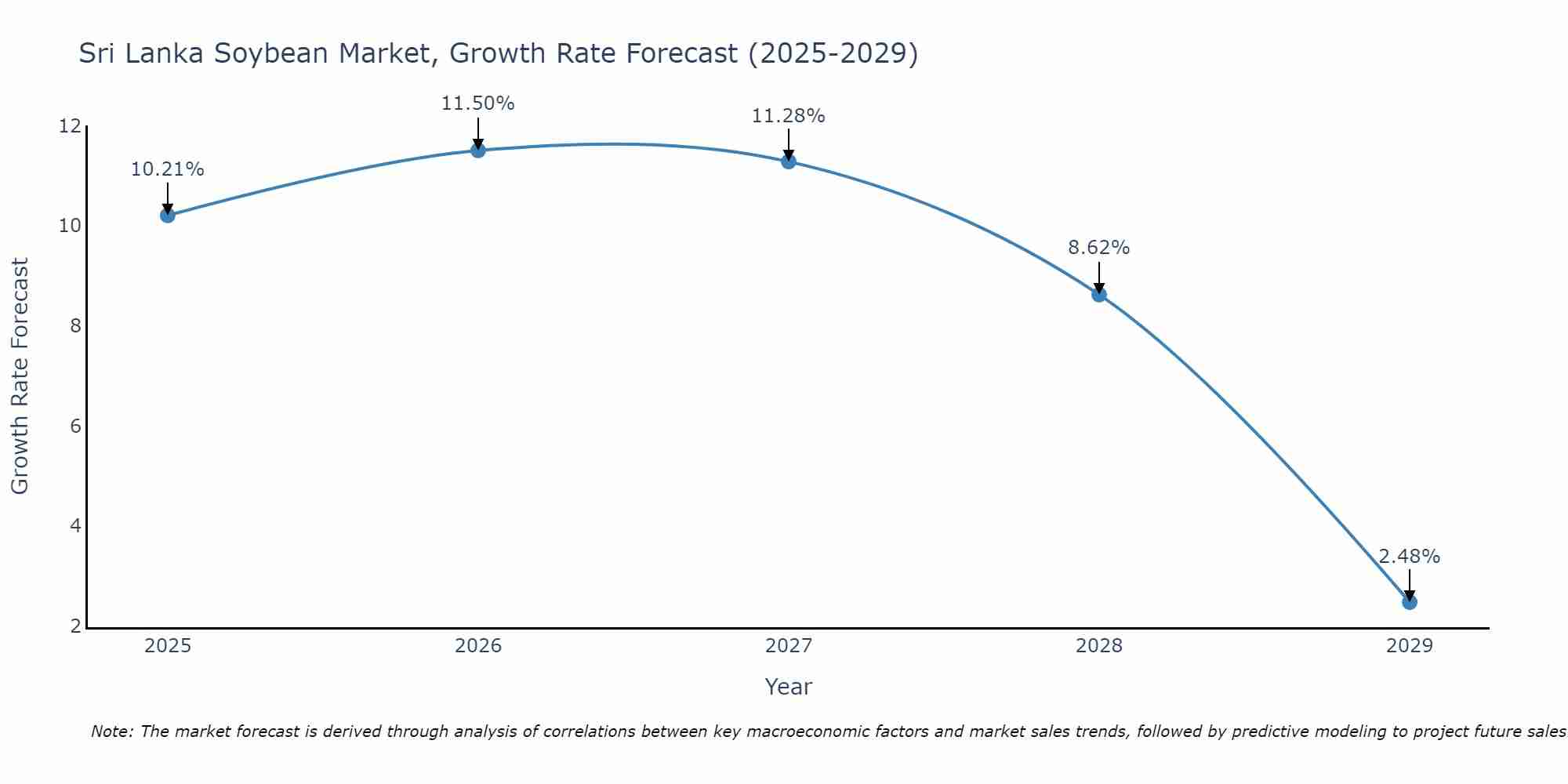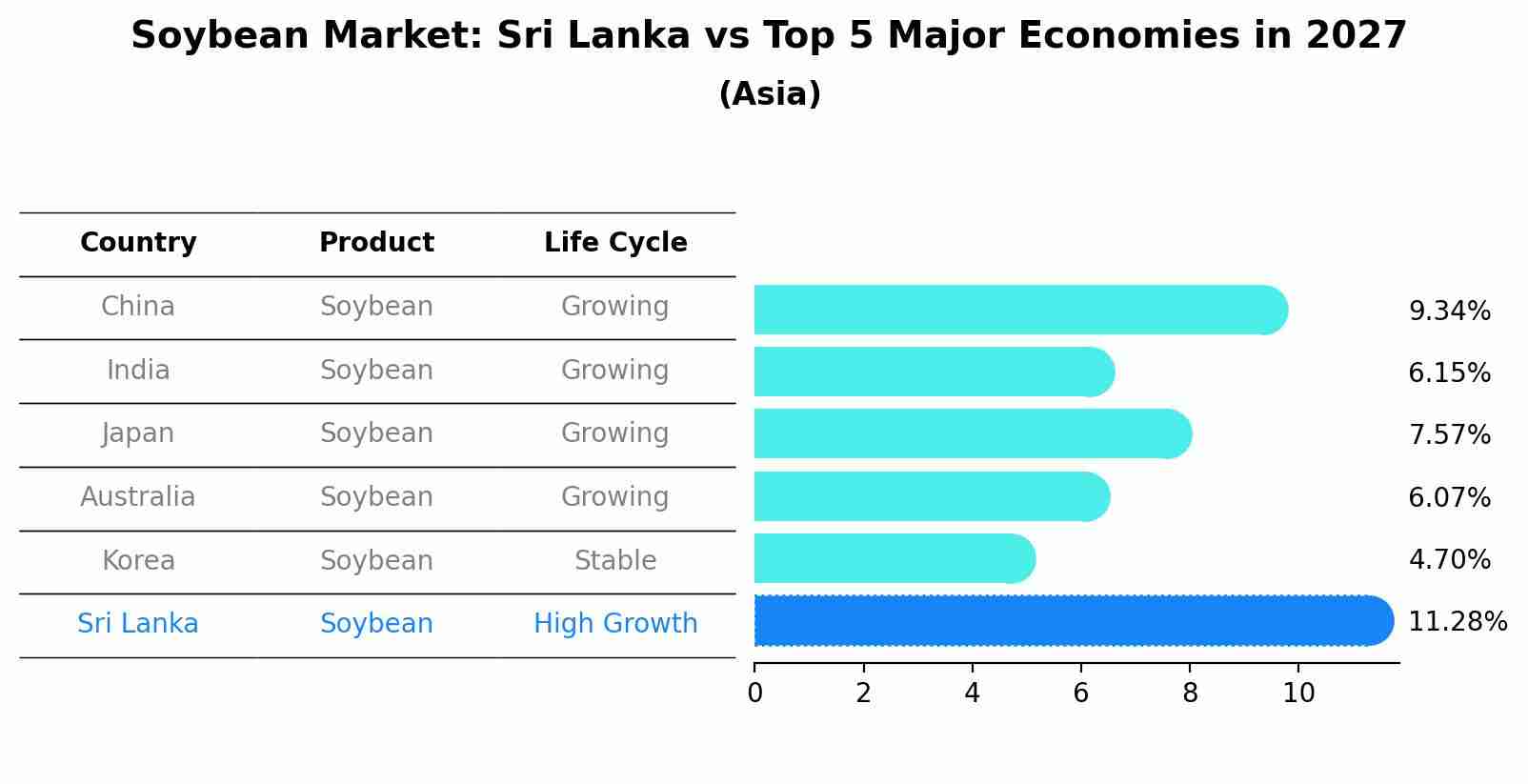Sri Lanka Soybean Market Outlook | COVID-19 IMPACT, Analysis, Value, Size, Trends, Revenue, Companies, Industry, Growth, Share & Forecast
| Product Code: ETC224671 | Publication Date: Aug 2022 | Updated Date: Jul 2025 | Product Type: Market Research Report | |
| Publisher: 6Wresearch | Author: Summon Dutta | No. of Pages: 75 | No. of Figures: 35 | No. of Tables: 20 |
Sri Lanka Soybean Market Size Growth Rate
The Sri Lanka Soybean Market is projected to witness mixed growth rate patterns during 2025 to 2029. The growth rate begins at 10.21% in 2025, climbs to a high of 11.50% in 2026, and moderates to 2.48% by 2029.

Soybean Market: Sri Lanka vs Top 5 Major Economies in 2027 (Asia)
The Soybean market in Sri Lanka is projected to grow at a high growth rate of 11.28% by 2027, within the Asia region led by China, along with other countries like India, Japan, Australia and South Korea, collectively shaping a dynamic and evolving market environment driven by innovation and increasing adoption of emerging technologies.

Sri Lanka Soybean Market Overview
The Sri Lankan soybean market is a growing sector driven by increasing consumer awareness of the health benefits associated with soy products. The demand for soybeans in Sri Lanka is primarily fueled by the growing popularity of soy-based products such as soy milk, tofu, and soy protein supplements. Local farmers are starting to cultivate soybeans to meet the rising demand, although the country still relies heavily on imports. The government is also actively promoting soybean cultivation to reduce dependency on imports and boost the local agricultural industry. While the market shows promise, challenges such as fluctuating global prices and competition from other protein sources remain. Overall, the Sri Lankan soybean market presents opportunities for both local farmers and international suppliers looking to capitalize on the growing demand for soy products in the country.
Sri Lanka Soybean Market Trends
The Sri Lankan soybean market is experiencing a growing demand due to the increasing awareness about the health benefits of soy products. Consumers are incorporating soy-based foods into their diets as a source of protein and other nutrients. The market is also witnessing a shift towards plant-based diets, driven by concerns over sustainability and animal welfare. Additionally, the food industry in Sri Lanka is increasingly utilizing soybean derivatives such as soy oil and soy protein in various products, further boosting the market growth. However, challenges such as fluctuating global soybean prices and competition from other protein sources remain key factors influencing the market dynamics. Overall, the Sri Lankan soybean market is poised for continued expansion, driven by changing consumer preferences and the rising demand for plant-based food products.
Sri Lanka Soybean Market Challenges
In the Sri Lanka soybean market, some key challenges include limited domestic production leading to a heavy reliance on imports, fluctuating global prices affecting affordability, and competition from other oilseed crops like coconut and palm. Additionally, the lack of awareness and consumer preference for traditional cooking oils over soybean oil poses a hurdle for market penetration. Infrastructure constraints, such as inadequate storage facilities and transportation networks, also impact the distribution and availability of soybean products across the country. Furthermore, regulatory barriers and import restrictions can hinder market growth and limit opportunities for market expansion. Overall, navigating these challenges requires strategic planning, market research, and targeted marketing efforts to promote the benefits of soybean products and increase consumer acceptance in Sri Lanka.
Sri Lanka Soybean Market Investment Opportunities
In the Sri Lanka soybean market, there are several investment opportunities worth considering. One potential avenue is investing in soybean production itself, as Sri Lanka currently imports a significant amount of soybeans for various purposes including food processing and animal feed. This presents an opportunity for investors to establish or support soybean farming operations within the country to meet the domestic demand. Additionally, there is potential for investment in soybean processing facilities to add value to the crop before it reaches the market. Another area of opportunity lies in the growing demand for soy-based products in Sri Lanka, such as soy milk and tofu, creating possibilities for investment in manufacturing and distribution of these products. Overall, the Sri Lanka soybean market offers diverse investment opportunities across the value chain for savvy investors.
Sri Lanka Soybean Market Government Policy
The Sri Lankan government has implemented policies aimed at reducing imports of soybeans and promoting domestic cultivation to achieve self-sufficiency. Some of the key measures include import restrictions, tariff increases on soybean imports, and providing subsidies and support to local soybean farmers. The government has also encouraged research and development initiatives to improve soybean production and increase yields. Furthermore, efforts have been made to promote sustainable farming practices and ensure quality standards are met in the soybean market. Overall, the government`s policies in Sri Lanka are focused on boosting domestic production, reducing reliance on imports, and supporting the growth of the soybean industry in the country.
Sri Lanka Soybean Market Future Outlook
The future outlook for the Sri Lanka soybean market appears promising, driven by increasing demand for soybean products in the food, feed, and industrial sectors. Factors such as growing health consciousness among consumers, rising disposable income levels, and expanding food processing industry are expected to fuel the demand for soybean products. Additionally, the government`s initiatives to promote sustainable agriculture practices and reduce dependency on imports by encouraging domestic soybean cultivation are likely to further boost the market growth. However, challenges like fluctuating international prices, climate change impact on crop yields, and competition from alternative protein sources could pose hindrances. Overall, the Sri Lanka soybean market is poised for steady growth, with opportunities for market players to innovate and cater to evolving consumer preferences.
Key Highlights of the Report:
- Sri Lanka Soybean Market Outlook
- Market Size of Sri Lanka Soybean Market, 2021
- Forecast of Sri Lanka Soybean Market, 2031
- Historical Data and Forecast of Sri Lanka Soybean Revenues & Volume for the Period 2018 - 2031
- Sri Lanka Soybean Market Trend Evolution
- Sri Lanka Soybean Market Drivers and Challenges
- Sri Lanka Soybean Price Trends
- Sri Lanka Soybean Porter's Five Forces
- Sri Lanka Soybean Industry Life Cycle
- Historical Data and Forecast of Sri Lanka Soybean Market Revenues & Volume By Applications for the Period 2018 - 2031
- Historical Data and Forecast of Sri Lanka Soybean Market Revenues & Volume By Crush for the Period 2018 - 2031
- Historical Data and Forecast of Sri Lanka Soybean Market Revenues & Volume By Feed Use for the Period 2018 - 2031
- Historical Data and Forecast of Sri Lanka Soybean Market Revenues & Volume By Food Use for the Period 2018 - 2031
- Sri Lanka Soybean Import Export Trade Statistics
- Market Opportunity Assessment By Applications
- Sri Lanka Soybean Top Companies Market Share
- Sri Lanka Soybean Competitive Benchmarking By Technical and Operational Parameters
- Sri Lanka Soybean Company Profiles
- Sri Lanka Soybean Key Strategic Recommendations
Frequently Asked Questions About the Market Study (FAQs):
1 Executive Summary |
2 Introduction |
2.1 Key Highlights of the Report |
2.2 Report Description |
2.3 Market Scope & Segmentation |
2.4 Research Methodology |
2.5 Assumptions |
3 Sri Lanka Soybean Market Overview |
3.1 Sri Lanka Country Macro Economic Indicators |
3.2 Sri Lanka Soybean Market Revenues & Volume, 2021 & 2031F |
3.3 Sri Lanka Soybean Market - Industry Life Cycle |
3.4 Sri Lanka Soybean Market - Porter's Five Forces |
3.5 Sri Lanka Soybean Market Revenues & Volume Share, By Applications, 2021 & 2031F |
4 Sri Lanka Soybean Market Dynamics |
4.1 Impact Analysis |
4.2 Market Drivers |
4.3 Market Restraints |
5 Sri Lanka Soybean Market Trends |
6 Sri Lanka Soybean Market, By Types |
6.1 Sri Lanka Soybean Market, By Applications |
6.1.1 Overview and Analysis |
6.1.2 Sri Lanka Soybean Market Revenues & Volume, By Applications, 2021-2031F |
6.1.3 Sri Lanka Soybean Market Revenues & Volume, By Crush, 2021-2031F |
6.1.4 Sri Lanka Soybean Market Revenues & Volume, By Feed Use, 2021-2031F |
6.1.5 Sri Lanka Soybean Market Revenues & Volume, By Food Use, 2021-2031F |
7 Sri Lanka Soybean Market Import-Export Trade Statistics |
7.1 Sri Lanka Soybean Market Export to Major Countries |
7.2 Sri Lanka Soybean Market Imports from Major Countries |
8 Sri Lanka Soybean Market Key Performance Indicators |
9 Sri Lanka Soybean Market - Opportunity Assessment |
9.1 Sri Lanka Soybean Market Opportunity Assessment, By Applications, 2021 & 2031F |
10 Sri Lanka Soybean Market - Competitive Landscape |
10.1 Sri Lanka Soybean Market Revenue Share, By Companies, 2021 |
10.2 Sri Lanka Soybean Market Competitive Benchmarking, By Operating and Technical Parameters |
11 Company Profiles |
12 Recommendations |
13 Disclaimer |
- Single User License$ 1,995
- Department License$ 2,400
- Site License$ 3,120
- Global License$ 3,795
Search
Thought Leadership and Analyst Meet
Our Clients
Related Reports
- Afghanistan Apparel Market (2026-2032) | Growth, Outlook, Industry, Segmentation, Forecast, Size, Companies, Trends, Value, Share, Analysis & Revenue
- Canada Oil and Gas Market (2026-2032) | Share, Segmentation, Value, Industry, Trends, Forecast, Analysis, Size & Revenue, Growth, Competitive Landscape, Outlook, Companies
- Germany Breakfast Food Market (2026-2032) | Industry, Share, Growth, Size, Companies, Value, Analysis, Revenue, Trends, Forecast & Outlook
- Australia Briquette Market (2025-2031) | Growth, Size, Revenue, Forecast, Analysis, Trends, Value, Share, Industry & Companies
- Vietnam System Integrator Market (2025-2031) | Size, Companies, Analysis, Industry, Value, Forecast, Growth, Trends, Revenue & Share
- ASEAN and Thailand Brain Health Supplements Market (2025-2031) | Strategy, Consumer Insights, Analysis, Investment Trends, Opportunities, Growth, Size, Share, Industry, Revenue, Segments, Value, Segmentation, Supply, Forecast, Restraints, Outlook, Competition, Drivers, Trends, Demand, Pricing Analysis, Competitive, Strategic Insights, Companies, Challenges
- ASEAN Bearings Market (2025-2031) | Strategy, Consumer Insights, Analysis, Investment Trends, Opportunities, Growth, Size, Share, Industry, Revenue, Segments, Value, Segmentation, Supply, Forecast, Restraints, Outlook, Competition, Drivers, Trends, Demand, Pricing Analysis, Competitive, Strategic Insights, Companies, Challenges
- Europe Flooring Market (2025-2031) | Outlook, Share, Industry, Trends, Forecast, Companies, Revenue, Size, Analysis, Growth & Value
- Saudi Arabia Manlift Market (2025-2031) | Outlook, Size, Growth, Trends, Companies, Industry, Revenue, Value, Share, Forecast & Analysis
- Uganda Excavator, Crane, and Wheel Loaders Market (2025-2031) | Strategy, Consumer Insights, Analysis, Investment Trends, Opportunities, Growth, Size, Share, Industry, Revenue, Segments, Value, Segmentation, Supply, Forecast, Restraints, Outlook, Competition, Drivers, Trends, Demand, Pricing Analysis, Competitive, Strategic Insights, Companies, Challenges
Industry Events and Analyst Meet
Whitepaper
- Middle East & Africa Commercial Security Market Click here to view more.
- Middle East & Africa Fire Safety Systems & Equipment Market Click here to view more.
- GCC Drone Market Click here to view more.
- Middle East Lighting Fixture Market Click here to view more.
- GCC Physical & Perimeter Security Market Click here to view more.
6WResearch In News
- Doha a strategic location for EV manufacturing hub: IPA Qatar
- Demand for luxury TVs surging in the GCC, says Samsung
- Empowering Growth: The Thriving Journey of Bangladesh’s Cable Industry
- Demand for luxury TVs surging in the GCC, says Samsung
- Video call with a traditional healer? Once unthinkable, it’s now common in South Africa
- Intelligent Buildings To Smooth GCC’s Path To Net Zero


















